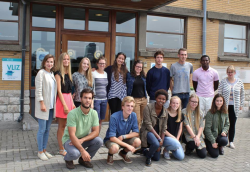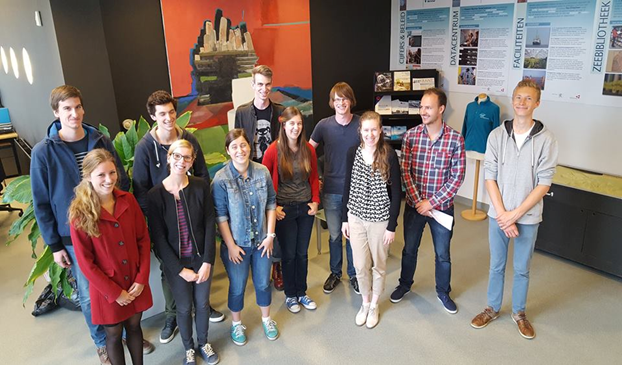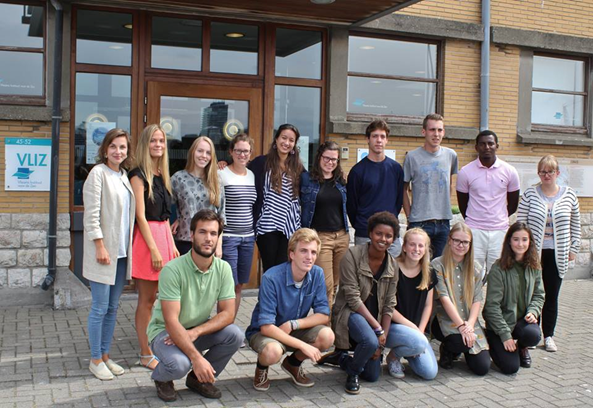LifeWatch Summer Students 2016
During July and August 2016, the Flanders Marine Institute (VLIZ) employed several summer students, of which 11 were assigned to the Flemish LifeWatch infrastructure.

Three summer students worked for the LifeWatch Marine Observatory and were based in the laboratories at the Marine Station Ostend (MSO). During the monthly and seasonal LifeWatch sampling campaigns with the RV Simon Stevin, macrobenthos samples are taken with the Van Veen grab, and zooplankton samples are taken with a WP2 plankton net. After each campaign, these raw samples are stored at the MSO, but not processed any further. Each summer, the students are asked to process all macrobenthos and zooplankton samples from the previous year. During July 2016, Yves De Blick separated and labelled 108 macrobenthos samples. Some raw samples still remain however. During August 2016, Serge Vermeiren worked with the ZooScan. After preparing the samples by rinsing the material and taking fractions of the sample, he then scanned the samples (i.e. taking a digital copy of the sample using the ZooScan), and provided the metadata. In the next step he converted the scanned samples with specialized software to generate a series of images, and finally he validated the converted samples by manually checking the identifications made by the software. In total he processed 137 samples (taken between June 2015 and July 2016). A third student, Lotte Van Peteghem (August 2016) prepared samples for the eDNA laboratory and analyzed samples for mitochondrial DNA (coi & cytB). (extraction of eDNA and qPCR).
The LifeWatch Data Archeology focuses on digitizing datasets from Belgian universities and institutes, and data from the Belgian Part of the North Sea. Several publications, theses, reports, etc. were identified as very interesting to digitize, but the VLIZ staff are simply lacking the time to do so. Therefore, each summer several students are involved in the LifeWatch Data Archeology activities. During July 2016, Gregory Steenkiste digitized a lot of (biota) data from old publications: (1) the PhD thesis of J. Govaere from 1978, (2) the expedition reports from the campaign “Expédition océanographique belge dans les eaux côtières africaines de l'Atlantique Sud (1948-1949): résultats scientifiques” (29 reports were available at the VLIZ library), and (3) a FKFO project report from 1983. During August 2016, Jens Boyen digitized shrimp fisheries data from 1947-1951 by Leloup, and quality controlled data from 1950-1990 from the Garnaalvisserij Database.
Since June 2015, the environment flag (marine-brackish-freshwater-terrestrial) is mandatory information for newly added species in the World Register of Marine Species (WoRMS), part of the LifeWatch Taxonomic Backbone. Furthermore, completing this information for species already available in WoRMS was identified as very high priority. The aim is to finalize this by the end of 2016, however, this is a very time consuming task. That’s why the help of the summer students is highly appreciated. During July 2016, Jan Bouwens and Elien Decock mainly searched for literature, preferably the original description of an organism, to complete the environment information of the species in the database. If these publications were not yet available in the WoRMS database, the full reference (and PDF if available) were added and linked to the species. During August 2016, Stephie Seghers continued this work on a part time basis. Together they were able to add the environment flag for 2.958 species, and 240 original descriptions with PDF were linked to the species.
Two more summer students worked on completing MarineRegions, the VLIZ Gazetteer which is also linked to the LifeWatch Taxonomic Backbone. During July 2016, Samuel Hernandez drafted the disclaimer for MarineRegions, and he prepared the coordinates for version 3 of the International Hydrographic Organization (IHO) – spatial data and naming of the world’s Seas and Oceans. During August 2016, Vasco Souza Dias prepared historical maps, created more than 1600 shapefiles for the MarineRegions gazetteer, and added missing coordinates to MarineRegions. And finally, also during July 2016, Sara Top georeferenced, analyzed (using mapanalalyst), and vectorized some 20 maps for HisGISKust, a project involving historical maps of the coastal zone).


Left: VLIZ summer students July 2016 - Right: VLIZ summer students August 2016
The LifeWatch Data Archeology focuses on digitizing datasets from Belgian universities and institutes, and data from the Belgian Part of the North Sea. Several publications, theses, reports, etc. were identified as very interesting to digitize, but the VLIZ staff are simply lacking the time to do so. Therefore, each summer several students are involved in the LifeWatch Data Archeology activities. During July 2016, Gregory Steenkiste digitized a lot of (biota) data from old publications: (1) the PhD thesis of J. Govaere from 1978, (2) the expedition reports from the campaign “Expédition océanographique belge dans les eaux côtières africaines de l'Atlantique Sud (1948-1949): résultats scientifiques” (29 reports were available at the VLIZ library), and (3) a FKFO project report from 1983. During August 2016, Jens Boyen digitized shrimp fisheries data from 1947-1951 by Leloup, and quality controlled data from 1950-1990 from the Garnaalvisserij Database.
Since June 2015, the environment flag (marine-brackish-freshwater-terrestrial) is mandatory information for newly added species in the World Register of Marine Species (WoRMS), part of the LifeWatch Taxonomic Backbone. Furthermore, completing this information for species already available in WoRMS was identified as very high priority. The aim is to finalize this by the end of 2016, however, this is a very time consuming task. That’s why the help of the summer students is highly appreciated. During July 2016, Jan Bouwens and Elien Decock mainly searched for literature, preferably the original description of an organism, to complete the environment information of the species in the database. If these publications were not yet available in the WoRMS database, the full reference (and PDF if available) were added and linked to the species. During August 2016, Stephie Seghers continued this work on a part time basis. Together they were able to add the environment flag for 2.958 species, and 240 original descriptions with PDF were linked to the species.
Two more summer students worked on completing MarineRegions, the VLIZ Gazetteer which is also linked to the LifeWatch Taxonomic Backbone. During July 2016, Samuel Hernandez drafted the disclaimer for MarineRegions, and he prepared the coordinates for version 3 of the International Hydrographic Organization (IHO) – spatial data and naming of the world’s Seas and Oceans. During August 2016, Vasco Souza Dias prepared historical maps, created more than 1600 shapefiles for the MarineRegions gazetteer, and added missing coordinates to MarineRegions. And finally, also during July 2016, Sara Top georeferenced, analyzed (using mapanalalyst), and vectorized some 20 maps for HisGISKust, a project involving historical maps of the coastal zone).


Left: VLIZ summer students July 2016 - Right: VLIZ summer students August 2016



